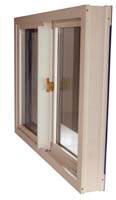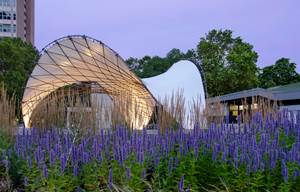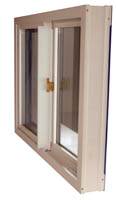Pultruded windows: Rising high?
New pultrudable glass fiber/resin formulations enable window manufacturers to break in to commercial architecture and build market share in residential construction.
There’s welcome news for those who pultrude fiberglass window profiles and lineals. A statistical review and forecast produced by the American Architectural Manufacturers Assn. (AAMA) predicts strong growth for these components in the coming years. The report comes on the heels of a decade-long roller coaster ride with unprecedented ups and downs for manufacturers of windows, doors and other architectural elements. In 2005, the total number of all types of window units shipped in the U.S. reached a new high of 70.5 million, but by 2009 that number had declined 45 percent to 38.9 million units (see “Shipments of prime windows” chart, p. 25). The good news is that the window market appears to be on the rebound, with 42.7 million units shipped in 2011 and projected shipments of more than 48 million windows this year. Of the 42.7 million windows shipped last year, vinyl windows accounted for 29.4 million units, or about 69 percent of the market. Wood windows, including vinyl-clad and metal-clad wood (20 percent), and aluminum (6 percent) were the second and third most-shipped windows. Fiberglass window profiles and frames, by comparison, captured a little more than 3 percent of the total market share, at 1.2 million units. However, annual shipments of fiberglass windows are forecast to more than double those recorded in 2009, reaching 2.6 million units per annum during 2014.
The growth in the use of pultruded fiberglass window components will be driven, in part, by new technology and an increasing demand in the market for windows that are capable of better performance. Pultruded fiberglass windows offer greater dimensional stability, impact resistance, strength and color fastness than the vinyl and wood windows that still dominate the residential construction market. But the dramatically improved thermal performance of fiberglass windows is promising gains in once out-of-reach commercial building construction, where fiberglass windows are increasingly seen as an attractive and viable alternative to aluminum windows.
The low thermal conductivity of fiberglass permits the design of windows with U values (the measure of thermal transmittance) two to three times better than those of their aluminum counterparts. Further, the manufacture of fiberglass consumes 57 times less energy than the manufacture of aluminum from bauxite, a selling point for companies and customers that want to establish their “green” credentials. With the cost of energy generally on the rise over the past decade, building architects and owners are realizing now that they can recoup the cost of replacing aluminum windows with fiberglass windows quite quickly — an awareness that is spreading with the emergence of “green” building programs in large cities, such as New York. Owner awareness and “green” initiatives have presented new opportunities for purveyors of fiberglass windows and those who pultrude the profiles and lineals.
One trailblazer in this effort is Serious Energy (Sunnyvale, Calif.). “Our mission is to displace aluminum with fiberglass in commercial buildings as soon as possible,” says Robert Clarke, the company’s director of marketing. A little more than two years ago, Serious Energy completed the replacement of steel and wood window frames with fiberglass frames in several buildings on the University of Colorado campus in Boulder, Colo. The project included two three-story buildings: Woodbury Hall — one of the university’s original structures, built in the late 19th century — and the Bruce Curtis Building (MCOL), a museum of natural history. At Woodbury Hall, eight large black-frame steel-and-aluminum windows were replaced, and the retrofit at the Bruce Curtis Building involved 84 beige-colored wood-framed windows (see photos on opening page).
The replacement windows were assembled at Serious Energy’s 36,000-ft2 (3,344m2) manufacturing facility in Boulder, Colo., using fiberglass profiles pultruded by Inline Fiberglass Ltd. (Toronto, Ontario, Canada).
For a third University of Colorado project, the $63 million Visual Arts Center, Serious used Inline’s family of 400 Series commercial “storefront” fiberglass lineals, completed in 2009. The lineals used in the three buildings comprise approximately 60 percent E-glass rovings, polyester resin and other chemical additives. Glass mat is used as reinforcement in corner and flange areas.
Larson Engineering (Chicago, Ill.) was contracted to verify that the pultrusions and overall window designs comply with International Building Code (IBC) standards and ensure, among other things, that the windows can withstand wind loads up to 110 mph/177 kph. This is an important consideration in Boulder, because its location in the foothills of Colorado’s Rocky Mountains makes it uniquely susceptible to occasional downslope winds of 80 to 100 mph (129 to 161 kmh). This fact presented a challenge because fiberglass pultruded profiles, in general, have only 25 percent of the strength through the cross-section that they have in the axial orientation. This makes fiberglass profiles more prone to deflection over long spans than aluminum or steel. Because some of the windows in the buildings are as tall as 130 inches/330 cm, steel reinforcement inserts were placed in certain sections of the profiles. The steel reinforcements were designed to be as thin as possible to minimize thermal transfer.
The fiberglass replacement windows damped sound better than the aluminum originals in all cases, and in the Bruce Curtis Building, where humidity must be kept relatively high (above 40 percent) to preserve the museum artifacts, the improved thermal performance of the fiberglass windows eliminated condensation that had formed on the aluminum frames.
Notably, color matching was not an issue. The window frames and sashes in the installations at Woodbury Hall and the Bruce Curtis Building were matched successfully to the colors of the previous windows. For the sake of architectural aesthetics, some windows in the Visual Arts Center were framed in “thermally broken” aluminum (an aluminum frame with an inside layer insulated from the outside layer). Clarke claims, “In areas where the fiberglass and aluminum windows are side by side, people cannot tell the difference due to the precise matching of black paint and substrate patina.”
New formulations could ramp up installations
Despite successes like these, applications of pultruded fiberglass windows in commercial architectural projects would be limited to low-rise commercial buildings (four stories and less) unless the flame and smoke characteristics and the structural properties of the polyester resin were significantly upgraded. During the past decade, window manufacturers have responded to that reality by investing significantly in R&D programs, and the work has borne fruit. Recently, several new materials have been commercialized that have the potential to open untapped markets for fiberglass window systems.
Inline Fiberglass, for example, has formulated a new polyester resin system with a fire retardant that achieves a Class B rating for flame spread and smoke density, as governed by ASTM E84-12, the standard test for determining the surface burning characteristics of building materials. The company is reportedly one of only two window manufacturers in North America (the other is Architectural Fiberglass, Cleveland, Ohio) to offer a Class B-rated glass-reinforced polyester window. According to the 2009 IBC standard, Class B windows can be installed in high-rise buildings if 10 percent or less of a building’s resulting external wall will be fiberglass. The Class A rating would be required if more than 10 percent of a building’s external walls will comprise fiberglass materials.
The Class B rating criteria require that a material must achieve a flame-spread index in the range of 25 to 75. Inline’s grade of polyester rated 30. Anthony Bartolini, Inline’s sales manager, reports that the development of the new resin was technically challenging because flame-spread and smoke-density properties are inversely correlated — that is, a larger percentage of flame-retardant additive can better slow flame spread but will increase smoke density. At the same time, too much additive can adversely affect structural properties. Nonetheless, Bartolini says the company is confident the material can meet the Class A rating (25 or less) for flame spread with adjustments to the additives package. That said, window frame and sash areas on commercial buildings rarely exceed the 10 percent fiberglass limit, so the Class B rating is sufficient for a host of new applications.
Another option is polyurethane (PU) resin. With two to three times the tensile strength, transverse strength and impact resistance of polyester, PU represents something of a gold standard for fiberglass window manufacturers that are interested in tapping advanced structural commercial applications. Its potential, however, has been blunted by a previously unmet twofold challenge: finding a glass/PU formulation that (1) will adhere to paint and (2) is in compliance with the IBC’s requirements for flame spread and smoke density for high-rise commercial buildings.
Graham Architectural Products (York, Pa.), however, claims that it recently became the first company in North America to bring to market a pultruded, glass-reinforced PU window that reportedly measures up in both categories. Trade named GThurm Windows, the product line features frames made from pultruded profiles that consist of approximately 80 percent continuous-strand glass and 20 percent PU. Graham Architectural partnered with Graham Engineering, a subsidiary that pultrudes the profile, and Bayer MaterialScience LLC (Pittsburgh, Pa.) to develop the proprietary PU resin blend. One of the critical innovations was the development of a postprocess surface treatment technology that ensures adhesion of the paint to the profile, an especially difficult challenge given the high glass content. As a result, customers can order GThurm windows in a variety of colors that are available in Arkema Inc.’s (King of Prussia, Pa.) line of Kynar paints, which has been approved by the AAMA for use on fiberglass window profiles.
Jaime Marrero, Graham Engineering’s pultrusion sales manager, says testing of the company’s profiles to ASTM E84-12 is ongoing, but he claims that Graham’s in-house tests confirmed that GThurm and aluminum windows perform “equally well” and do not support ignition. The glass/PU windows have a U value of less than 0.18. The first commercial installations of GThurm windows were retrofits for several buildings on Bayer MaterialScience’s Pittsburgh campus (see photos, this page). Marrero reports that Graham Architectural has orders on the books for several other projects, including retrofit installations at a municipal police building.
For its part, Inline has created a new division within the company dedicated solely to the development and manufacture of pultruded, glass-reinforced PU windows. The company says it will launch its first PU product this spring. Company president Bernard Rokicki says Inline has developed a proprietary process to produce a glass/polyurethane window lineal that does not require painting because color is provided via an in-process decoration technique. At present, the plan is to market the window to light industrial and low-rise commercial buildings.
Hoping for high-rise approval
Serious Energy’s Clarke believes these new material formulations bode well for the future of installations in high-rise office building applications that were previously off limits to fiberglass windows. He reports that his company is working with the New York City mayor’s Office of Energy to obtain approval for plans to retrofit an eight-story building with Class B fire-rated fiberglass windows. Clarke is confident that approval will be granted but cautions that there are still hurdles that manufacturers and window marketeeers must clear before there is widespread acceptance of fiberglass in large commercial buildings.
“Aluminum has been entrenched in the industry for 40-plus years,” he says, “so there are some significant infrastructure constraints in terms of tooling, dies, fixtures, brackets, etc., none of which work at all with fiberglass.” Still, Clarke argues that there is no inherent practical impediment to, or valid argument against, replacement of aluminum with an IBC-approved fiberglass formulation that has appropriate reinforcements. “Displacing aluminum is an absolute ‘should,’” says Clarke.
As the company’s effort in New York City demonstrates, however, the benefits of fiberglass materials will not sell themselves. Window manufacturers will have to work closely with architects and construction firms and navigate the political machinery of local and state governments to make Clarke’s imperative a reality.
Residential growth: Looking to looks
The same properties that make fiberglass windows an attractive choice for commercial buildings (i.e., low thermal conductivity, durability, dimensional stability and sound-damping properties) also make them more appealing in the residential market. The hindrance to enlarging market share in this highly competitive arena has been the higher price point of fiberglass windows, especially in comparison to vinyl products. In response, window manufacturers are adding to their superior structural performance and greater longevity an aesthetic component that is helping to provide a degree of separation between fiberglass windows and the rest of a very crowded field.
Al Dueck, president of Duxton Windows and Doors (Winnipeg, Manitoba, Canada), says he is encountering more customers that are disinclined to use either aluminum or vinyl for retrofits and new construction. “Aluminum windows are poor insulators and vinyl has reached a certain level of maturity where people are seeing the limits of its durability, color choices and styles,” Dueck observes.
Duxton targets a higher-end niche market by manufacturing a line of energy efficient windows with a variety of unique colors, finishes and patinas, as well as custom details. The company purchases its lineals from Inline Fiberglass. Duxton is supplying Echo-Logic Land Corp. (Calgary, Alberta, Canada) with fiberglass triple-pane, low-emission windows for a demonstration community of “zero emission” houses in the province. Suspended film between each pane of glass creates separate chambers that are filled with argon gas. The window system reduces winter heat loss and summer heat gain by as much as 80 percent compared to conventional double-pane windows. “Our focus is strictly on fiberglass and the benefits it provides,” Dueck says. “We don’t try to appeal to everyone.”
Teel Plastics (Baraboo, Wis.) supplies complex pultruded door thresholds and sills for windows, doors and skylights to a number of major window and door manufacturers. The company can produce profiles reinforced by aramid and carbon fiber, as well as glass, in a variety of thermoset matrices, including vinyl ester, polyester and epoxy. Tom Thompson, Teel’s CFO, says the company’s flexibility and range of pultrusion capabilities has positioned it well to capture the upswing in demand for better performing doors and windows with unique aesthetics. “A fiberglass window is the last window a person will ever need,” Thompson claims. “You can’t say that about vinyl.” He anticipates double-digit growth as the uptick in the construction market continues over the next few years.
Visual appeal is the goal for Inline’s newest line of windows, the Eternity 9000 Double Hung Series. Sales manager Bartolini says the main difference between the Eternity and the company’s old line of double-hung windows, the Sovereign Series, is design aesthetics. “We’ve minimized the trim, maximized the sight line, added contoured edges and made the window sexier to the eyes,” he says. Customers can choose from five standard colors and a range of custom colors and finishes, including a red oak veneer for the interior finish. But its appeal isn’t only to the eye. The Eternity 9000 Double Hung Series also is designed to accommodate the more stringent 2013 Energy Star rating, with an enhanced glazing pocket of 1.125 inches/28.6 mm, which allows the window to accommodate the thicker insulated glass units used in triple-glazed applications. “A glazing pocket this wide is unheard of for double-hung windows,” Bartolini says.
As the economy and the building construction market show signs of recovery, pultruders are overcoming technical and aesthetic challenges — from precise color matching to structural load-bearing capabilities — in the manufacture of window frame lineals. As they do, fiberglass windows are shedding their image as too costly and/or impractical for not only residential construction but also for elusive commercial buildings. Builders and building owners are taking a second look at the aesthetic and performance benefits afforded by fiberglass. If the building construction market continues to rebound — an outcome the current economic reality does not yet guarantee — pultruders are well positioned to capitalize on an economic upturn. In fact, pultruders could see growth in their window business greater than that in the prerecession economy, even if the coming boom is smaller.
Related Content
Biocomposite for mobile architecture, low load-bearing applications
The German Institutes of Textile and Fiber Research and partners have developed a biocomposite well suited for support profiles and connecting nodes in construction applications.
Read MoreExel Composites pultruded rods enhance Umbrosa parasol durability
The Belgium-based manufacturer chose pultruded fiberglass ribs for many of its umbrella and parasol designs to effectively endure exposure to high wind speeds, saltwater, rain and UV.
Read MorePull-wound carbon fiber poles enable lightweight, compact, rigid emergency stretcher
Based on military feedback, Epsilon Composite developed an optimized, foldable stretcher that combines telescopic pull-wound carbon fiber tubes.
Read MoreNovel processes for hybrid thermoset-thermoplastic pultruded parts
CFRP pultrusion and pullwinding specialist Epsilon Composite combines thermoplastic overmolding with traditional thermoset processes, demonstrated through aircraft struts and industrial applications.
Read MoreRead Next
Pultruded Heavy Commercial Window an Industry First
Composites add strength and insulating value, improving occupant comfort and reducing energy cost.
Read More“Structured air” TPS safeguards composite structures
Powered by an 85% air/15% pure polyimide aerogel, Blueshift’s novel material system protects structures during transient thermal events from -200°C to beyond 2400°C for rockets, battery boxes and more.
Read More


























